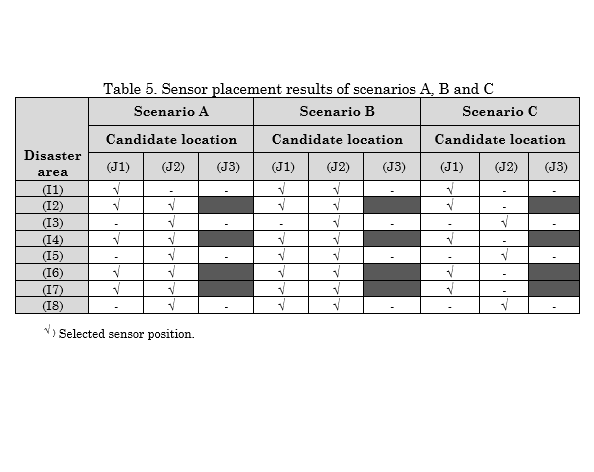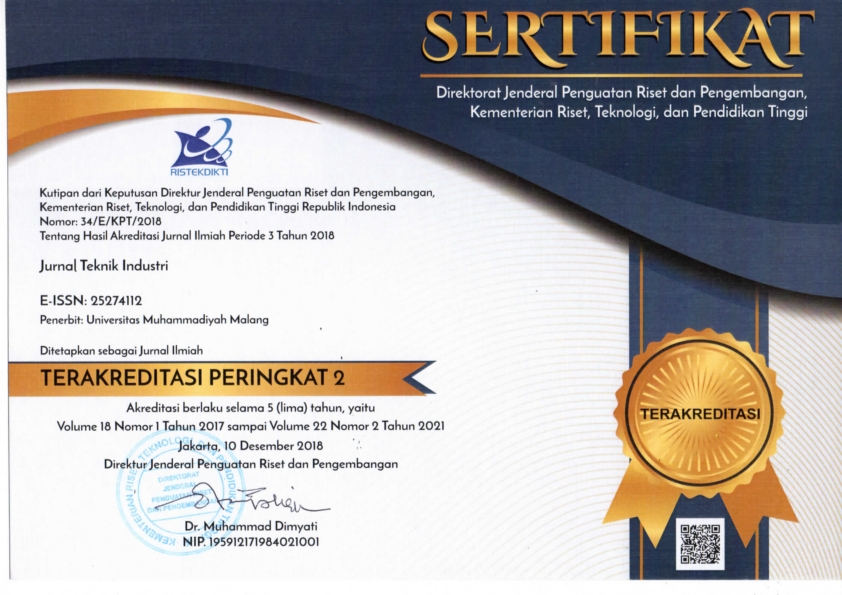A MILP Model for Water Level Sensor Placement with Multi-Sensor and Multi-Disaster Areas
DOI:
https://doi.org/10.22219/JTIUMM.Vol22.No2.185-195Keywords:
FEWS, IoT System, Android Application, MILP, Sensor Optimal LocationsAbstract
A water level sensor is critical to measure water levels at strategic points in the river. The sensor location directly impacts the quality of the collected data sent to the flood early warning system. To prevent and minimize the risk of flooding, it is crucial to determine the optimal locations for water level sensor placement. This research proposes a Mixed-Integer Linear Programming (MILP) model for water level sensor placement considering multi-sensor and multi-disaster areas. In addition, this model was applied in a case study in Tikala River, Manado, Indonesia. The results indicated that all disaster areas could be covered by at least one single sensor. A sensitivity analysis was performed by running the model under several different budget scenarios. When the budget increases, the number of sensors and the coverage performance are getting larger. Thus, the proposed MILP model was able to determine the optimal locations for sensor placement under a limited budget.
Downloads
References
I. Kairupan, K. Dame, and I. Masala, " Mechanical Design for Flooding Detection System Using Motor Direct Current Control Based On Arduino," Global Scientific Journal, vol. 7, no. 9, 2019.
I. F. Astuti, A. N. Manoppo, and Z. J. S. Arifin, "Sistem peringatan dini bahaya banjir kota Samarinda mengunakan sensor ultrasonic berbasis mikrokontroler dengan buzzer dan SMS," vol. 22, no. 1, pp. 30-34, 2018. https://jurnal.wicida.ac.id/index.php/sebatik/article/view/209.
M. Ayaz, M. Ammad-Uddin, and I. J. I. S. J. Baig, "Wireless sensor’s civil applications, prototypes, and future integration possibilities: A review," vol. 18, no. 1, pp. 4-30, 2017. http://doi.org/10.1109/JSEN.2017.2766364.
D. Satria, S. Yana, R. Munadi, and S. Syahreza, "Flood Early Warning Information System For Multilocation Based Android," International Journal of Engineering Technologies Management Research, vol. 5, no. 8, pp. 47-53, 2018. https://doi.org/10.29121/ijetmr.v5.i8.2018.279.
I. Kairupan, Z.-Y. Huang, H.-C. Chang, and C.-W. Chang, "Emergency navigation and alarm with flooding models—A real case study of Manado City," in 2016 International Conference On Communication Problem-Solving (ICCP), 2016, pp. 1-2: IEEE. http://doi.org/10.1109/ICCPS.2016.7751120.
L. Sitanayah, A. Angdresey, and E. Kristalino, "A sensor-based application for road conditions detection: poster abstract," presented at the Proceedings of the 18th Conference on Embedded Networked Sensor Systems, Virtual Event, Japan, 2020. http://doi.org/10.1145/3384419.3430437.
Y.-C. Tseng, M.-S. Pan, and Y.-Y. Tsai, "Wireless sensor networks for emergency navigation," Computers & Chemical Engineering, vol. 39, no. 7, pp. 55-62, 2006. http://doi.org/10.1109/MC.2006.248.
Q. Shi, X. Wang, W. Chen, and K. Hu, "Optimal sensor placement method considering the importance of structural performance degradation for the allowable loadings for damage identification," Applied Mathematical Modelling, vol. 86, pp. 384-403, 2020. https://doi.org/10.1016/j.apm.2020.05.021.
M. Rebolledo, S. Chandrasekaran, and T. Bartz-Beielstein, "Sensor Placement for Contamination Detection in Water Distribution Systems,", 2020.
S. Bianco and F. Tisato, "Sensor placement optimization in buildings," in Image Processing: Machine Vision Applications V, 2012, vol. 8300, p. 830003: International Society for Optics and Photonics. https://doi.org/10.1117/12.911021.
X. Xu, Y. Lu, S. Huang, Y. Xiao, and W. Wang, "Incremental sensor placement optimization on water network," in Joint European Conference on Machine Learning and Knowledge Discovery in Databases, 2013, pp. 467-482: Springer. https://link.springer.com/chapter/10.1007/978-3-642-40994-3_30.
J. Wu, D. Ma, W. Wang, and Z. Han, "Research on sensor placement for disaster prevention in water distribution networks for important users," Sustainability, vol. 12, no. 2, p. 723, 2020 2020. https://doi.org/10.3390/su12020723.
A. R. Ferrolino, J. E. C. Lope, and R. G. Mendoza, "Optimal location of sensors for early detection of tsunami waves," in International Conference on Computational Science, 2020, pp. 562-575: Springer. https://doi.org/10.1007/978-3-030-50417-5_42.
G. Fattoruso et al., "Optimal sensors placement for flood forecasting modelling," Procedia Engineering, vol. 119, pp. 927-936, 2015. https://doi.org/10.1016/j.proeng.2015.08.971.
A. Puri, K. Valavanis, and M. Kontitsis, "Statistical profile generation for traffic monitoring using real-time UAV based video data," in 2007 Mediterranean Conference on Control & Automation, 2007, pp. 1-6: IEEE. http://doi.org/10.1109/MED.2007.4433658.
R. Soman, P. Kudela, K. Balasubramaniam, S. K. Singh, and P. Malinowski, "A study of sensor placement optimization problem for guided wave-based damage detection," Sensors, vol. 19, no. 8, p. 1856, 2019. https://doi.org/10.3390/s19081856.
M. Nasir and A. Syafiul, "Optimalisasi Penempatan Sensor Untuk Pengukuran Distribusi Tekanan Model Kapal Bersayap," Wave: Jurnal Ilmiah Teknologi Maritim, vol. 5, no. 1, pp. 32-36, 2011. https://doi.org/10.29122/jurnalwave.v5i1.3358.
V. Akbarzadeh, J.-C. Lévesque, C. Gagné, and M. Parizeau, "Efficient sensor placement optimization using gradient descent and probabilistic coverage," Sensors, vol. 14, no. 8, pp. 15525-15552, 2014. https://doi.org/10.3390/s140815525.
T. Nishida, N. Ueno, S. Koyama, and H. Saruwatari, "Sensor placement in arbitrarily restricted region for field estimation based on Gaussian process," in 2020 28th European Signal Processing Conference (EUSIPCO), 2021, pp. 2289-2293: IEEE. http://doi.org/10.23919/Eusipco47968.2020.9287222.
T. H. Yi, H. N. Li, and M. Gu, "Optimal sensor placement for structural health monitoring based on multiple optimization strategies," The Structural Design of Tall Special Buildings, vol. 20, no. 7, pp. 881-900, 2011. https://doi.org/10.1002/tal.712.
C. Livia, "Usulan Penjadwalan Produksi untuk Meminimalkan Total Tardiness dengan Metode Integer Linear Programming Pada Bagian Produksi Printing PT Mitra Mulia Makmur," Jurnal Teknik Industri, vol. 18, p. 127, 2017. http://doi.org/10.22219/JTIUMM.Vol18.No2.127-137.
A. C. Lasut, P. F. Opit, and R. Rottie, "The MILP Model for Locating the Temporary Disaster Emergency Operation Centers in Manado Indonesia," Jurnal Teknik Industri, vol. 21, no. 1, pp. 46-57, 2020. https://doi.org/10.22219/JTIUMM.Vol21.No1.46-57.
H. D. Wahjono and G. Setiaji, "Instalasi Sistem Pemantauan Kualitas Air Online Berbasis GSM di Sungai Ciliwung Segmen Istiqlal," Jurnal Air Indonesia, vol. 8, no. 1, 2018. http://dx.doi.org/10.29122/jai.v8i1.2384.
R. Riyandari, "“Water Front City” Mitigasi Bencana Banjir Di Kelurahan Dendengan Luar, Kota Manado," Jurnal Sains dan Teknologi Mitigasi Bencana, vol. 13, no. 1, pp. 57-64, 2018. https://doi.org/10.29122/jstmb.v13i1.3361.
B. Laurensz, F. Lawalata, and S. Y. J. Prasetyo, "Potensi Resiko Banjir dengan Menggunakan Citra Satelit (Studi Kasus: Kota Manado, Provinsi Sulawesi Utara)," Indonesian Journal of Computing Modeling, vol. 2, no. 1, pp. 17-24, 2019. https://ejournal.uksw.edu/icm/article/view/2536.
C. Hill, F. Verjee, and C. Barrett, "Flash flood early warning system reference guide," University Corporation for Atmospheric Research: Boulder, CO, USA, p. 204, 2010 2010.
G. B. Sahetapy and H. Poli, "Analisis Jalur Evakuasi Bencana Banjir Di Kota Manado," SPASIAL, vol. 3, no. 2, pp. 70-79, 2016. https://ejournal.unsrat.ac.id/index.php/spasial/article/view/12536.
Y. Sudamara, B. F. Sompie, and R. J. Mandagi, "Optimasi penanggulangan bencana banjir Di kota manado dengan metode AHP (analytical hierarchy process)," Jurnal Ilmiah Media Engineering, vol. 2, no. 4, 2012.
F. S. Gay, F. Warouw, and E. D. Takumansang, "Perencanaan Kawasan Sempadan Sungai Sawangan di Kota Manado," SPASIAL, vol. 5, no. 1, pp. 105-117, 2018. https://ejournal.unsrat.ac.id/index.php/spasial/article/view/19284.
H. A. Telah, J. A. Rombang, and H. D. Walangitan, "Modeling Tutupan Lahan di DAS Tikala Berdasarkan Kapasitas Saluran Sungai Tikala," EUGENIA, vol. 24, no. 2, 2018. https://doi.org/10.35791/eug.24.2.2018.22805.
D. Makasaehe, L. A. Hendratta, and J. S. Sumarauw, "Kajian Pemetaan Banjir Dengan Hec–Georas Studi Kasus: Sungai Tondano," JURNAL SIPIL STATIK, vol. 8, no. 3, 2020. https://ejournal.unsrat.ac.id/index.php/jss/article/view/28750.
N. Yuniarti, D. Hariyanto, S. Yatmono, and M. Abdillah, "Design and Development of IoT Based Water Flow Monitoring for Pico Hydro Power Plant," nt. J. Interact. Mob. Technol., vol. 15, no. 7, pp. 69-80, 2021. https://doi.org/10.3991/ijim.v15i07.18425.

Downloads
Published
How to Cite
Issue
Section
License
Copyright (c) 2021 Prudensy F Opit, Indah Yessi Kairupan, Fribianty M Rusuh

This work is licensed under a Creative Commons Attribution-ShareAlike 4.0 International License.











